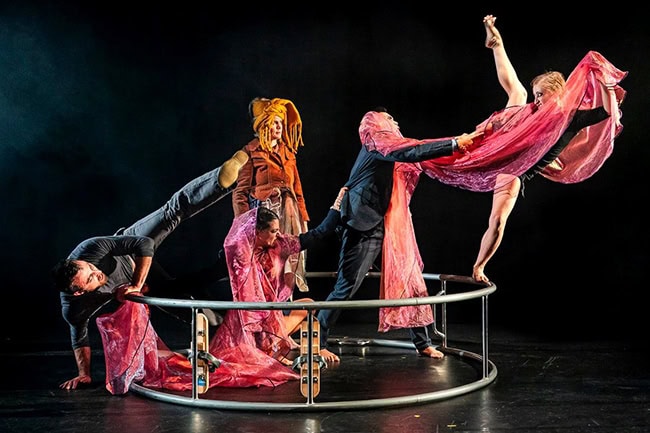Neus Gil Cortés’ reworking of Quimera at Jacksons Lane
Posted: January 11th, 2020 | Author: Nicholas Minns | Filed under: Performance | Tags: Chiara Corbetta, Clara Pinto, Daniel Phung, Delia Ceruti, Francesc Serra Vila, Isabelle Innocenzi, Jacksons Lane, Jordi Pérez, Neus Gil Cortés, Nich Galzin, Nick Murray, Sarah Dowling | Comments Off on Neus Gil Cortés’ reworking of Quimera at Jacksons LaneNeus Gil Cortés, Quimera, Jacksons Lane, October 19

Choreographer Neus Gil Cortés is adept at creating works of rich imagination that rely on a heightened visual quality; this performance of her Quimera at Jacksons Lane is a re-working of an earlier version. In its first iteration, Quimera was a new departure in that Cortés took on aspects of theatre and circus to tell a story, based loosely on Miguel Cervantes satirical novel, Don Quixote. Using an actor — Sarah Dowling — in the central role supported by circus artists (Delia Ceruti and Nich Galzin) as well as dancers (Cortés and Daniel Phung), the production suffered from the physical integration of circus paraphernalia like the German Wheel which appeared awkwardly out of scale. In this reworking, Cortés has not altogether disentangled herself from the initial framework, but she has managed to integrate it into a surreal landscape, drawing her ideas together into a dream-like narrative reminiscent of Cervantes’ novel. The achievement is as much cinematic as choreographic; she has extended her visual sense with superimposed images that, by colouring the narrative, provide not only motion but emotion. Within this dynamic scheme, even the imposing presence of the German Wheel has found its place with multiple significations.
In Cervantes’ novel, the bandit Roque explains to Don Quixote his way of life, which is not unlike that of a reconstructive choreographic process: ‘Now I am in, I must go through; one sin draws on another in spite of my better designs; and I am now in such a chain of wrongs, factions, abetters and engagements, that no less than the divine power of providence can free me from this maze of confusion. Nevertheless I despair not still of a successful end of my misfortunes.’
It may well have been the divine power of providence that helped Cortés rearrange Quimera, but there is perhaps a more pragmatic reason: because she was pregnant with her first child, she took herself out of the original cast (she is replaced by Chiara Corbetta) and assumed a more directorial role; instead of being in the film, she has placed herself both behind the camera where she can reimagine her material, and in the cutting room where she can edit it.
The arc of Quimera moves from the rhetorical to the mythical, beginning in the audience where Dowling sits before getting up to wonder out loud what being a hero means, what it is like to be someone who believes they can change the world. Stepping on to the stage she enters the world of illusion in which her own heroic journey is to play out. The program note describes her as ‘a retiree named Quimera’ whose working life is reflected in the opening mechanical routine of office workers sitting in a row of imaginary desks. It is staged at the speed of a time lapse with accelerated entrances and exits without pause for reflection. In a blackout we hear a door closing and silence; it is only in her tiny room that Quimera counters the ticking clock with her own expanding sense of time. She tidies her clothes, places a bucket under a leak, and looks at herself in the mirror. She picks up a book, puts it down, and is on the point of leaving when we see a man with a backpack passing by; Cortés is beginning to choreograph the inside of Quimera’s head which becomes a phantasmagoria costumed brilliantly by Clara Pinto and her assistant Isabelle Innocenzi. A performer crawls on stage with a baguette in her hand, and an interlocked couple attempts to kiss; there’s a conga line and a religious procession with a statuesque Madonna that clears the way for the entry of Galzin and his German Wheel as a windmill. Quimera fights it with her baguette and ends up trapped inside as it lies on the ground. Tempted by sirens on ropes, and carried off by bandits, she bravely fights back only to watch recent events rewind like a film until she finds herself once again in her room.
Just as Dowling began in the audience, so now members of the audience walk on to the stage, bringing time back to the present and dispelling the illusion. Quimera/Dowling as antihero laments this world is not easy for an idealist, but Cortés — along with set designer Francesc Serra Vila, lighting designer Jordi Pérez, composer Nick Murray, and the two costume designers — has fought for her choreographic ideals and won the battle of Quimera. Now she is free to begin a new adventure.